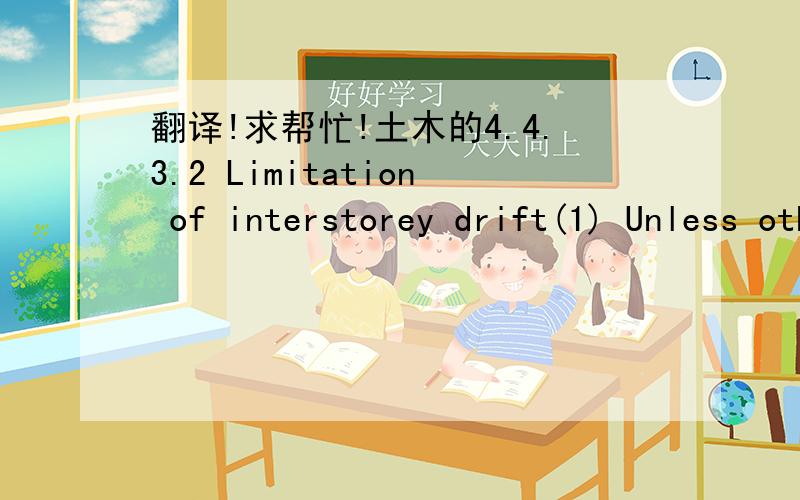翻译!求帮忙!土木的4.4.3.2 Limitation of interstorey drift(1) Unless otherwise specified in Sections 5 to 9, the following limits shall beobserved:a) for buildings having non-structural elements of brittle materials attached to thestructure:dr
来源:学生作业帮助网 编辑:作业帮 时间:2024/05/11 21:39:21

翻译!求帮忙!土木的4.4.3.2 Limitation of interstorey drift(1) Unless otherwise specified in Sections 5 to 9, the following limits shall beobserved:a) for buildings having non-structural elements of brittle materials attached to thestructure:dr
翻译!求帮忙!土木的
4.4.3.2 Limitation of interstorey drift
(1) Unless otherwise specified in Sections 5 to 9, the following limits shall be
observed:
a) for buildings having non-structural elements of brittle materials attached to the
structure:
drν ≤ 0,005h ; (4.31)
b) for buildings having ductile non-structural elements:
drν ≤ 0,0075h ; (4.32)
c) for buildings having
non-structural elements fixed in a way so as not to interfere with
structural deformations, or without non-structural elements:
drν ≤ 0,010 h (4.33)
where:
dr is the design interstorey drift as defined in 4.4.2.2(2);
h is the storey height;
ν is the reduction factor which takes into account the lower return period of the
seismic action associated with the damage limitation requirement.
(2) The value of the reduction factor ν may also depend on the importance class of
the building.
Implicit in its use is the assumption that the elastic response spectrum of
the seismic action under which the “damage limitation requirement” should be met (see
3.2.2.1(1)P). has the same shape as the elastic response spectrum of the design seismic
action corresponding to the “ultimate limit state requirement” in accordance with
2.1(1)P and 3.2.1(3)
翻译!求帮忙!土木的4.4.3.2 Limitation of interstorey drift(1) Unless otherwise specified in Sections 5 to 9, the following limits shall beobserved:a) for buildings having non-structural elements of brittle materials attached to thestructure:dr
4.4.3.2 Limitation of interstorey drift
楼层间漂移极限
(1) Unless otherwise specified in Sections 5 to 9,the following limits shall be observed:
除第5至9节另有规定者外,应遵守下列限制:
a) for buildings having non-structural elements of brittle materials attached to the structure:
对于有脆性材料的非结构性单元依附于结构物的建筑物:
drν ≤ 0,005h ; (4.31)
b) for buildings having ductile non-structural elements:
对于有延性的非结构性单元的建筑物:
drν ≤ 0,0075h ; (4.32)
c) for buildings having non-structural elements fixed in a way so as not to interfere with structural deformations,or without non-structural elements:
对于有以不影响结构变形为目的安装的非结构性单元,或没有非结构性单元的建筑物:
drν ≤ 0,010 h (4.33)
where:
其中:
dr is the design interstorey drift as defined in 4.4.2.2(2);
dr是4.4.2.2(2)中规定的设计楼层间漂移;
h is the storey height;
h是楼层高度;
ν is the reduction factor which takes into account the lower return period of the seismic action associated with the damage limitation requirement.
v是考虑到与损失极限要求相关的地震活动间隔期较低的换算系数(折减系数).
(2) The value of the reduction factor ν may also depend on the importance class of the building.Implicit in its use is the assumption that the elastic response spectrum of the seismic action under which the “damage limitation requirement” should be met (see 3.2.2.1(1)P).has the same shape as the elastic response spectrum of the design seismic action corresponding to the “ultimate limit state requirement” in accordance with 2.1(1)P and 3.2.1(3)
换算系数v的值也可能取决于该建筑物的重要等级.其作用中隐含着的是,对地震活动时弹性反应谱应满足的“损失极限要求”的假定(见…).3.2.2.1(1)P)与设计地震活动弹性反应谱的形状相同,该设计地震活动是与“最大极限状态要求”相一致的,而该“最大极限状态要求”是依据2.1(1)P 和 3.2.1(3)的.
4 4 3 2限制interstorey漂移(1)除非另有说明在章节5到9,下列限制:一)应当beobserved建筑拥有非结构性元素附加到组成的脆性材料:drν≤0005 h;(4.31)b)对建筑有韧性非结构性元素:drν≤0,0075 h;(4.32)c)对建筑有非结构性元素固定在某种程度上,以免干扰withstructural变形,或没有非结构性元素:drν≤0010 h(4.33)地点:...
全部展开
4 4 3 2限制interstorey漂移(1)除非另有说明在章节5到9,下列限制:一)应当beobserved建筑拥有非结构性元素附加到组成的脆性材料:drν≤0005 h;(4.31)b)对建筑有韧性非结构性元素:drν≤0,0075 h;(4.32)c)对建筑有非结构性元素固定在某种程度上,以免干扰withstructural变形,或没有非结构性元素:drν≤0010 h(4.33)地点:interstorey博士是设计中定义漂流4 4 2 2(2);h是层高;ν是换算系数,考虑了低重现期持行动相关的损害限制要求。(2)折减系数的值也可能取决于ν重要性是建筑类。它的使用是隐含在假设弹性反应谱在地震作用下的“损害限制要求“应该遇到了(见3 2 2 1(1)P)。有相同的形状的弹性反应谱的设计seismicaction对应于“极限状态要求“按照历经1(1)P和3.2.1(3)
收起
4.4.3.2限制层间位移
(1)除非在部分5至9另有规定,下列限制应
观察:
一)具有脆性材料附着于非结构构件的建筑
结构:
ν博士≤0005h;(4.31)
B)有韧性的非结构构件的建筑:
ν博士≤00075h;(4.32)
C)建筑物
非结构构件固定的方式以免干扰
结构变形,或没有非结构构件:
ν博士≤0...
全部展开
4.4.3.2限制层间位移
(1)除非在部分5至9另有规定,下列限制应
观察:
一)具有脆性材料附着于非结构构件的建筑
结构:
ν博士≤0005h;(4.31)
B)有韧性的非结构构件的建筑:
ν博士≤00075h;(4.32)
C)建筑物
非结构构件固定的方式以免干扰
结构变形,或没有非结构构件:
ν博士≤0010小时(4.33)
在哪儿。
DR是设计的层间位移定义4.4.2.2(2);
H是层高;
ν是减少的因素需要考虑的低回报期
地震作用下的损伤相关的限制要求。
(2)的折减系数ν价值还取决于重要的类
建筑。
在其使用中隐含的假设是,弹性反应谱
地震作用下,“损害限制要求”应满足(见
3.2.2.1(1)P)。具有相同的形状作为设计地震弹性反应谱
动作对应于“极限状态的要求,按照
2.1(1)和(3)P 3.2.1
收起